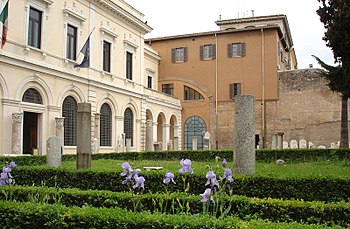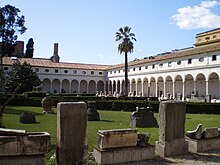Museo Nazionale Romano
The Museo Nazionale Romano , founded in 1889, is located in Rome and is now divided into five locations:
Palazzo Massimo alle Terme, Aula Ottagona, Palazzo Altemps , Diocletian's Baths and Crypta Balbi .
The archaeological collection is one of the most important in the world.
Palazzo Massimo alle Terme
The Palazzo Massimo alle Terme is located on Largo di Villa Peretti, diagonally opposite the Termini train station .
The palazzo was built between 1883 and 1887 on the site of the former Villa Peretti in the style of the 16th century. The villa and its park were inherited by the noble Roman Massimo family . The Jesuit Massimiliano Massimo had the older Palazzo Peretti (or Palazzo Sisto ) demolished for the new building . He made the new Palazzo Massimo alle Terme available to the restored Jesuit school, now known as Istituto Massimiliano Massimo . After the school moved out in 1960, the Italian state bought the building in 1981 and had it converted for the Museo Nazionale Romano . The palazzo now houses sculptures , portraits and reliefs from the period of the late Roman Republic and the early Imperial period . These include a statue of Augustus , two statues of Apollo , the girl from Antium and the sarcophagus from Portonaccio . There are also two statues of a Greek ruler (so-called thermal ruler ) and the Quirinal pugilist , which are temporarily exhibited in the Aula Ottagona . They are of particular importance as only a few Greek bronzes of this quality and size have survived to this day. Also are wall paintings from the Villa of Livia and the decoration of the Casa della Farnesina visit. There are also exhibits from the Nemi ships and the jewelery collection with the gem of Aspasios .
The numismatic section (medagliere) includes coins from ancient times , the Middle Ages and modern times . The Münzkabinett (over 110,000 coins), which King Victor Emanuel III, who died in exile, owned, is significant . bequeathed to the Italian people. Only a fraction of the around 500,000 objects in the Medagliere is on display, the rest is in an underground vault.
Also in the basement, the mummy of Grottarossa , the mummy of an eight-year-old Roman girl, which is dated to the middle of the 2nd century AD, is exhibited in a separate room . In addition to the mummy itself, the rich grave goods are exhibited and explained.
Aula Ottagona
The Aula Ottagona is located in Via Romita.
It was originally part of the Baths of Diocletian. In ancient times, here was with marble and stucco designed Frigidarium . In 1609 the building was used by Paul V as a granary. In 1928 it was converted into a planetarium.
To get an insight into the design of the great Roman thermal baths of the 2nd – 4th centuries According to the 17th century, the auditorium was decorated with a number of marble and bronze sculptures .
Palazzo Altemps
The Palazzo Altemps is located at Piazza di S. Apollinare 44 near Piazza Navona .
It was built in 1585 for Cardinal Mark Sittich von Hohenems (Italian: Marco Sittico Altemps) and houses collections of classic works of art. This includes the Ludovisi collection with 104 sculptures, including Orestes and Elektra , Ares and the head of Juno , as well as a Greek original from the 5th century BC. With the name "Ludovisian Throne". Another collection is that of Cardinal Hohenems, which includes 15 sculptures from Greek and Roman antiquity. The Mattei and Del Drago collections and an Egyptian collection can also be viewed.
Baths of Diocletian (Terme di Diocleziano)
The Baths of Diocletian are located on Viale Enrico De Nicola.
This part of the Museo Nazionale Romano is housed in the cloisters and outbuildings of the Church of Santa Maria degli Angeli e dei Martiri , which were built into the Baths of Diocletian. Here are works of art, finds and inscriptions. In the garden in front of the church, graves from the time of the Roman Republic and the imperial era were discovered during restoration work.
Crypt Balbi
location
The Crypta Balbi , the name follows the regional arias of the fourth century, and the department named after it Museo Nazionale Romano are located between today's streets Via dei Delfini, Via Caetani and Via delle Botteghe Oscure (house number 31).
Modern use
The museum is dedicated to the urban development of Rome. The archaeological finds in the area offer the opportunity to reconstruct life in Rome from the early imperial era to modern times.
Antiquity
Excavations uncovered the remains of the portico with the portico and exedra of the theater complex Theater des Balbus , built by Lucius Cornelius Balbus Minor , which is often referred to as a crypt because of the associated cryptoporticus . The crypt adjoined the theater directly to the east and ran around a rectangular courtyard, in the middle of which was a building whose use is no longer known today. The crypt was used by the theater visitors as a place to stay during the theater performances, which often ran for days.
The theater was built on the Field of Mars and was one of three theaters there when it was built in 13 BC. Was inaugurated. In the immediate vicinity of the theater there were several temples and later the Porticus Minucia . Among the temples there was also the Temple of Vulcanus , this and inscriptions find evidence that blacksmiths were settled around the theater. The Porticus Minucia, which adjoined the theater and crypt in the north, served as a distribution point for rations of grain to Roman citizens.
Construction began on the theater and the crypt in 19 BC. Tuff and travertine blocks were used to build the theater , and concrete cast in opus reticulatum to build the semicircular auditorium . The crypt was behind the theater and was also built with travertine and tuff and partly with brickwork. The crypt was directly connected to the stage building of the theater and was laid out around a square courtyard, in the middle of which there was a building that is only occupied by the Forma Urbis Romae . The eastern side of the crypt opened into a semicircular exedra . During the time of Emperor Titus , the Balbi crypt was damaged by fire and repair work then took place under Emperor Domitian .
Individual evidence
- ^ Palazzo Massimo alle Terme on romasegreta.it
- ↑ Bollettino di Numismatica 1/2012 on numismaticadellostato.it
- ↑ Medagliere on beniculturali.it ( Memento of the original from November 1, 2017 in the Internet Archive ) Info: The archive link has been inserted automatically and has not yet been checked. Please check the original and archive link according to the instructions and then remove this notice.
- ↑ "Mummia di Grottarossa" - on the website of the Sopritendenza Speciala per i beni archeologici di Roma ( Memento of September 8, 2014 in the Internet Archive )
- ↑ Roman Monument Authority ( Memento of the original from June 25, 2008 in the Internet Archive ) Info: The archive link was inserted automatically and has not yet been checked. Please check the original and archive link according to the instructions and then remove this notice.
- ^ Text in Lacus Curtius ; see. Daniele Manacorda: Crypta Balbi: Archeologia e storia di un paesaggio urbano . 2nd edition Milan 2003, p. 23.
- ^ Daniele Manacorda: Crypta Balbi: Archeologia e storia di un paesaggio urbano . 2nd edition Milan 2003, p. 24, fig. 14.
- ^ Daniele Manacorda: Crypta Balbi: Archeologia e storia di un paesaggio urbano . 2nd ed. Milan 2003, pp. 28-29.
- ^ Daniele Manacorda: Crypta Balbi: Archeologia e storia di un paesaggio urbano . 2nd edition Milan 2003, p. 25.
literature
- Maria Stella Arena u. a. (Ed.): Roma dall'Antichità al Medioevo: Archeologia e storia nel Museo Nazionale Romano Crypta Balbi . Milan 2001. In it:
- Paolo Delogu: Roma dall'antichità al medioevo: La storia . Pp. 13-19.
- Roberto Meneghini, Riccardo Santangeli Valenzani: La trasformazione del tessuto urbano tra V e IX secolo . Pp. 20-33.
- Lucia Saguì: Roma e il Mediterraneo: la circolazione delle Merci . Pp. 62-28.
- Lucia Saguì: La circolazione delle Merci: Il deposito della fine del VII secolo nell´ esedra della Crypta Balbi . Pp. 266-267.
- Lucia Saguì: L'esedra della Crypta Balbi tra tardo antico e alto medioevo . Pp. 593-594.
- Filippo Coarelli : Il Campo Marzio . Rome 1997.
- Daniele Manacorda: Museo Nazionale Romano: Crypta Balbi . English version. Milan 2000.
- Daniele Manacorda: Crypta Balbi: Archeologia e storia di un paesaggio urbano . 2nd Edition. Milan 2003.
- D. Mancini, Marco Ricci, Daniele Manacorda: La Forma Urbis alla Crypta Balbi: Novità dagli scavi . In: Archeo 207 (2002), pp. 38-44.
- Lidia Paroli u. a. (Ed.): Roma dall'Antichità al Medioevo II: contesti tardoantichi e altomedievali . Milan 2004. In it:
- Marco Ricci: Crypta Balbi: l'area del mitreo . Pp. 231-241.
- Diletta Romei: Produzione e circolazione dei manufatti ceramici a Roma nell'alto medioevo . Pp. 278-311.
- Lucia Saguì, Caterina Maria Coletti: Contesti tardoantichi dall'area a SE della Crypta Balbi . Pp. 242-277.
- Laura Vendittelli: Crypta Balbi: stato e prospettive della ricerca archeologica nel complesso . Pp. 222-230.
Web links
- Museum website (Italian)
Coordinates: 41 ° 54 ′ 5 ″ N , 12 ° 29 ′ 54 ″ E

